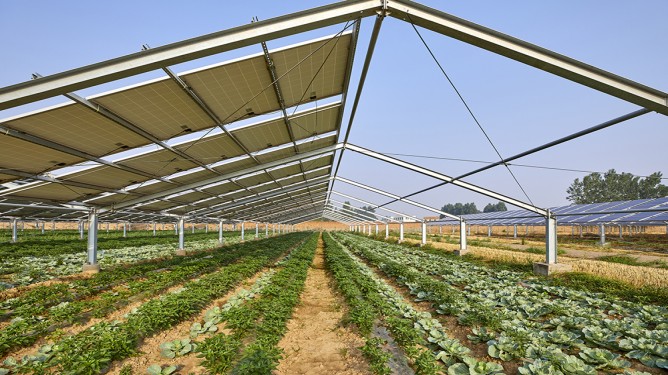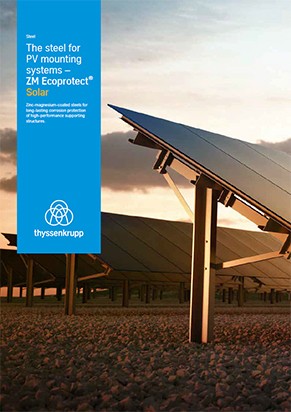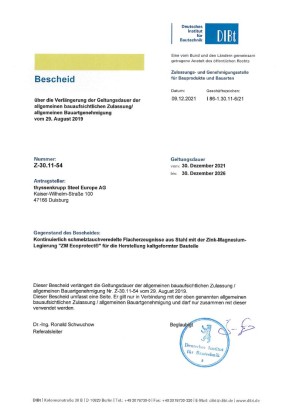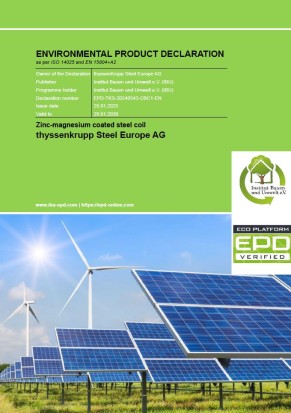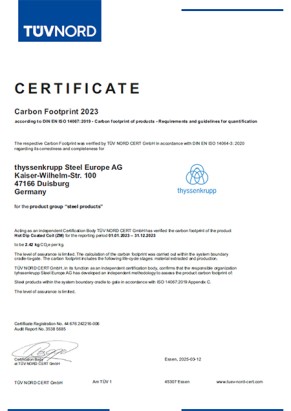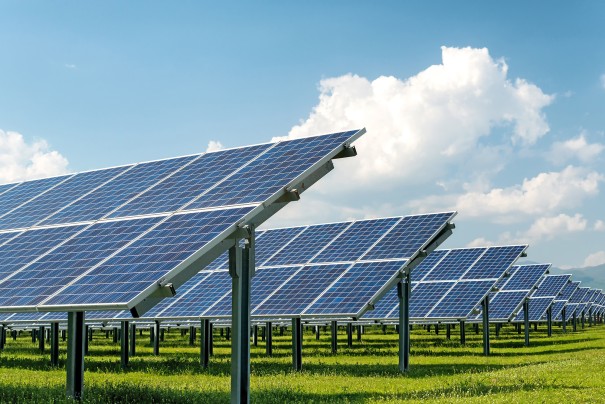
The solar package adopted by the German government in August 2023 will give photovoltaics in Germany an additional boost. "We need to triple the pace and succeed in adding 22 gigawatts annually by 2026 to meet our expansion targets," said German Economics Minister Robert Habeck in a press release issued along with the decision. Based on 2022, an additional capacity of only 7.5 gigawatts has been installed, which is not nearly enough to build the total planned capacity of 215 gigawatts of photovoltaics in Germany by 2030.
Significant funding for agrivoltaics
Capacities must be built up, especially in the free-field sector, in order for new solar installations to be connected to the grid on the desired scale. Experts see great development potential in what is called agrivoltaics. This involves installing PV systems on agricultural land in a way that does not restrict its agricultural use. A good example of this are pastures for cattle or poultry farming which are spanned by PV mounting structures. Similar concepts exist for fruit and vegetable cultivation; indeed, PV systems even add value here since they offer protection against extreme weather conditions such as hail. The plan is for these and similar approaches to be promoted more strongly in the future through the German government's initiative. Robert Habeck: "A key focus of the package is to provide land for solar parks in a sustainable and environmentally friendly manner, so that agricultural land is used twice over with agrivoltaics – for agriculture and for power generation.
thyssenkrupp Steel, the partner of the solar supply industry
The challenge: because the materials of the mounting systems are exposed to extreme weather conditions in the open air, it must be ensured that no metal particles will get into the soil due to corrosion processes. As a partner of the energy sector with great expertise in materials, thyssenkrupp Steel is actively addressing these new requirements. The advantage: with ZM Ecoprotect® Solar, the manufacturer already has a suitable basic product. The coating is already being used today for robust solar mounting racks and, with its zinc-magnesium-based corrosion protection, is ideal for use in outdoor areas.
The König company from Moringen has already had good experience with ZM Ecoprotect® Solar. As a producer of special profiles, the company's product range includes high-quality components for solar mounting racks. Managing director Meiko Fiedler appreciates that thyssenkrupp is involved in the process in a variety of ways: "Not only do we get the material we need for manufacturing, but we also receive expert consulting services for the required material specifications and corrosion protection. This is very important in lightweight construction because, aside from efficiency, it goes without saying that we need high rigidity and durability in the design at all times." Fiedler also appreciates the possibility of being able to source CO2-neutral steel grades in the future. "Sustainability is increasingly important for us and our customers – especially when it comes to renewable energies. With bluemint® Steel, thyssenkrupp is providing us with a suitable solution for the future."
ZM coatings: Intensive research work and portfolio expansion

Sustainability and ecological compatibility are also relevant to agrivoltaics in other ways. Jennifer Schulz, development engineer at thyssenkrupp Steel: "Depending on the area of application, the location of the mounting rack and the nature of the soil, it is necessary to adapt the coatings and subsequent treatments, such as passivations. For example, because no heavy metal such as chromium is allowed to be present." Against this background, thyssenkrupp Steel is also benefiting from the investments in its own production network. "The new hot-dip galvanizing line (FBA) 6 with its state-of-the-art coater affords us the opportunity of testing novel chrome-free pre- and post-treatments efficiently. This means we can successfully respond to the specific requirements of new markets," Schulz added. The option of coating thicker sheets or higher-strength steels in the FBA 6 also gives the manufacturer more scope for developing innovative products in the future.
thyssenkrupp Steel is supporting the various development approaches to the topic of agrivoltaics through intensive studies in the company's own corrosion laboratories. thyssenkrupp Steel has engaged external partners and institutes, such as the Karlsruhe Institute of Technology (KIT), to carry out additional test series. Individual material properties are also repeatedly tested. The most recent example concerns how coatings made of ZM Ecoprotect® Solar behave in soils and whether they are resistant to a range of pH values. "Such tests and corresponding validations are important so that farmers know whether they can stick to proven fertilizers despite the steel profiles being anchored in the ground," explains Arne Schreiber from thyssenkrupp Steel's Industry Product Management.
Agrivoltaics are picking up speed
Solar providers and their material suppliers still have a lot of convincing to do to make the dual use of land for agriculture and energy production more popular. To date, agrivoltaics accounts for just one percent of free-field solar installations. "However, the topic was already widely known and talked about among those attending industry events such as the leading trade fair Intersolar. And we notice how the importance is increasing elsewhere too. This will be an important building block for the energy turnaround," Arne Schreiber is certain. "That's why we're already paying a lot of attention to the issue."
ZM Ecoprotect® Solar: Available steel grades, coatings and dimensions for agrivoltaic applications
Hot-dip coated structural steel
DIN EN 10346
| Dimensions | |||
|---|---|---|---|
| Steel grade designation |
Coatings in g/m2 |
Thickness1 from _ to in mm |
Width1 from _ to in mm |
| S220GD |
ZM310, ZM430 | 0.60 – 4.00 | 700 – 1,560 |
| S250GD |
ZM310, ZM430 | 0.60 – 4.00 | 700 – 1,560 |
| S280GD |
ZM310, ZM430 | 0.60 – 4.00 | 700 – 1,560 |
| S320GD |
ZM310, ZM430 | 0.60 – 4.00 | 700 – 1,560 |
| S350GD |
ZM310, ZM430 | 0.60 – 4.00 | 700 – 1,560 |
| S390GD | ZM310, ZM430 | 0.60 – 4.00 | 700 – 1,560 |
| S420GD | ZM310, ZM430 | 0.60 – 4.00 | 700 – 1,560 |
| S450GD | ZM310, ZM430 | 0.60 – 4.00 | 700 – 1,560 |
| S550GD | ZM310, ZM430 | 1.80 – 3.00 | 700 – 1,560 |
Mild steel
DIN EN 10346
| Dimensions | |||
|---|---|---|---|
| Steel grade designation |
Coatings in g/m2 |
Thickness1 from _ to in mm |
Width1 from _ to in mm |
| DX51D | ZM310, ZM430 | 0.60 – 3.00 | 700 – 1,560 |
| DX52D | ZM310, ZM430 | 0.60 – 3.00 | 700 – 1,560 |
| DX53D | ZM310, ZM430 | 0.60 – 3.00 | 700 – 1,560 |
| DX54D | ZM310, ZM430 | 0.60 – 3.00 | 700 – 1,560 |
| DX56D | ZM310, ZM430 | 0.60 – 3.00 | 700 – 1,560 |
Micro-alloyed steel
DIN EN 10346
| Dimensions | |||
|---|---|---|---|
| Steel grade designation |
Coatings in g/m2 |
Thickness1 from _ to in mm |
Witdh1 from _ to in mm |
| HX260LAD | ZM310, ZM430 | 0.40 – 6.00 | 700 – 1,560 |
| HX300LAD | ZM310, ZM430 | 0.40 – 6.00 | 700 – 1,560 |
| HX340LAD | ZM310, ZM430 | 0.40 – 6.00 | 700 – 1,560 |
| HX380LAD | ZM310, ZM430 | 0.40 – 6.00 | 700 – 1,560 |
| HX420LAD | ZM310, ZM430 | 0.40 – 6.00 | 700 – 1,560 |
